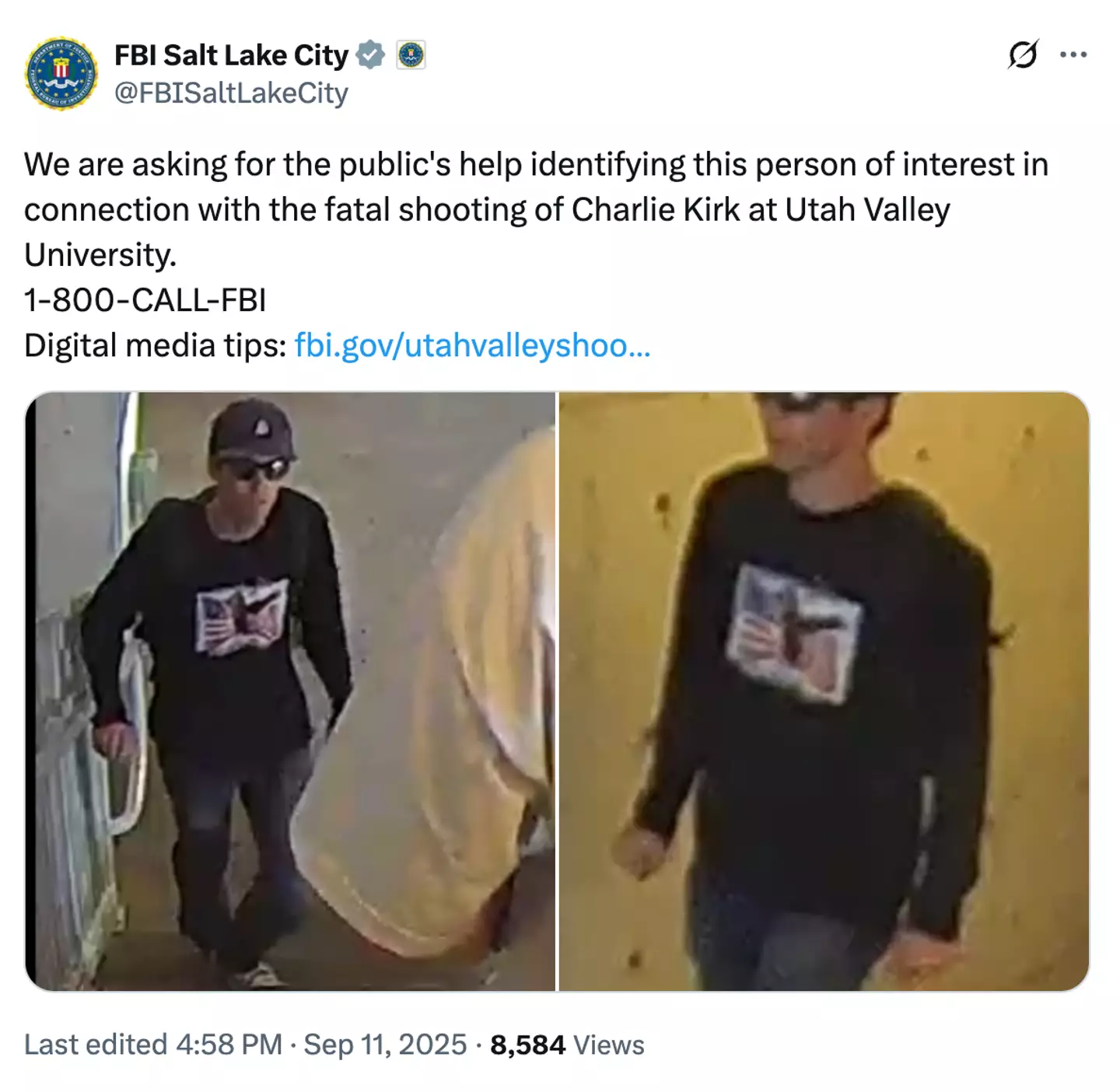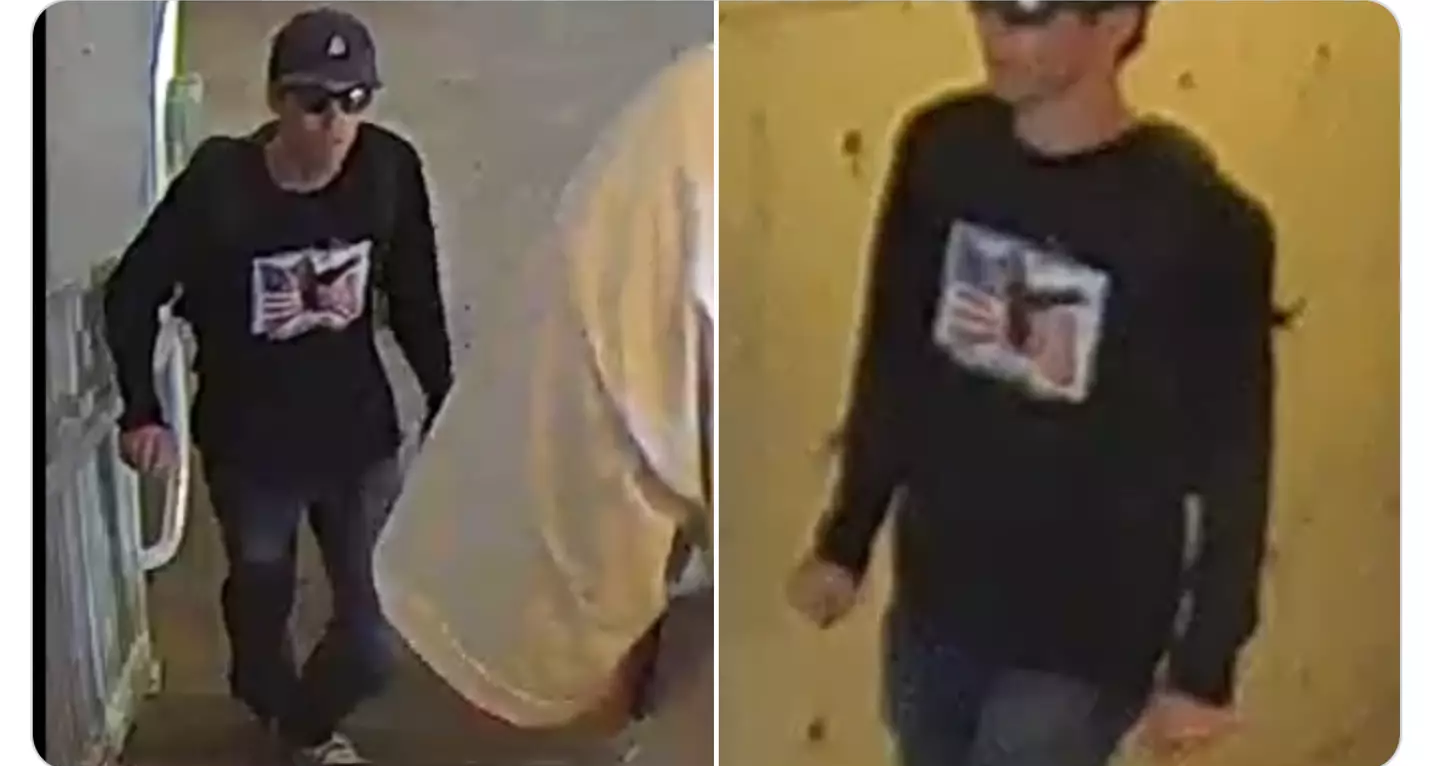Introduction: A Nation Still Reeling
One day after the shocking assassination of conservative activist Charlie Kirk at Utah Valley University, the FBI’s Salt Lake City office has released a photo of a person of interest linked to the crime. The image, posted to X (formerly Twitter) on September 11, has already ricocheted across social media platforms, with thousands of users sharing, speculating, and demanding answers.
The post from the FBI is simple, yet chilling: “We are asking for the public’s help identifying this person of interest in connection with the fatal shooting of Charlie Kirk at Utah Valley University. 1-800-CALL-FBI.”
The image itself — grainy but distinct enough to recognize features — has become the centerpiece of a rapidly expanding investigation. For millions who watched Kirk’s final moments in viral videos, the photo represents both a glimmer of hope for justice and a haunting reminder of how fragile public life has become in America.
The Context: Charlie Kirk’s Assassination
On September 10, at approximately 1 p.m. local time, Kirk was shot in the neck while participating in a Q&A with students at Utah Valley University in Orem, Utah. Witnesses described the sound of a single shot echoing through the courtyard where hundreds had gathered. Panic broke out instantly, with students diving for cover, faculty members screaming for order, and the crowd dispersing in every direction.
Video footage, recorded from multiple angles, captured the devastating moment. Kirk, standing under a white canopy, was struck mid-sentence. He collapsed as aides rushed to him, while terrified students cried out in disbelief.
Law enforcement quickly determined the shot had come from an elevated position — the roof or upper levels of the Losee Center, a campus building roughly 200 yards from where Kirk was speaking. The precision and timing of the strike immediately raised suspicions that the shooter had planned the attack carefully.
By late afternoon, the news was confirmed by none other than Donald Trump, who took to Truth Social to announce Kirk’s death. The announcement sent shockwaves through conservative and liberal circles alike, sparking both grief and a renewed debate about the state of political discourse in the United States.
The FBI Steps In
With national attention bearing down, the FBI announced late Tuesday night that it was joining the investigation alongside the ATF, Utah County Sheriff’s Office, and Orem Police Department. By the next morning, their presence was visible across campus: black SUVs, heavily armed agents, and crime scene tape sealing off large portions of university grounds.
The release of the photo on September 11 marked the first major public development since the killing. Though officials declined to call the individual depicted a “suspect,” their language was clear: this was someone who may have been involved, or who might hold key information about the assassin’s identity and movements.
The decision to release the image so soon after the attack underscores both the urgency of the investigation and the difficulty authorities face in tracking a perpetrator who appears to have vanished without a trace.
What the Photo Shows
The FBI did not provide details about how or when the image was captured, but sources close to the investigation suggest it came from campus surveillance cameras near the Losee Center.
The photo shows a young man of college age, wearing a dark hoodie and carrying a backpack. His head is partially turned away from the camera, but his face is visible enough for potential identification. Investigators believe he may have blended in with the student population, an unsettling detail that suggests careful planning.
Public reaction to the photo has been swift. Online forums are buzzing with theories — some pointing to the person’s clothing, others noting similarities to individuals seen in crowd videos from the day of the shooting. Conspiracy theories, already rampant since Kirk’s death, have now exploded, with users dissecting the photo pixel by pixel.
For the FBI, however, the message remains straightforward: they need help, and they are turning to the public to provide it.
The Search for the Shooter
While the release of the photo gives the public its first tangible clue, investigators remain cautious. Law enforcement has not confirmed whether the individual fired the fatal shot or is simply connected to someone who did.
The initial confusion surrounding a supposed “suspect in custody” — later retracted by university officials — has already complicated public perception of the case. On social media, critics accuse authorities of mishandling the situation, while others argue that the release of a photo without more context risks misidentification.
Nevertheless, the FBI appears determined to harness public vigilance. The phone number included in the post, 1-800-CALL-FBI, is a direct line for tips, and officials have emphasized that even the smallest detail could prove crucial.
Political Reactions
The FBI’s move has drawn comment from across the political spectrum.
Conservative allies of Kirk praised the agency for acting quickly, urging supporters to share the image widely. “Let’s find this coward,” one right-wing influencer posted to X, attaching the FBI photo.
Democratic leaders, while condemning the assassination, warned against vigilante behavior. “We must let the investigation run its course,” said Senator Cory Booker. “Speculation online can put innocent people at risk.”
Former President Trump, meanwhile, reiterated his call for prayers for Kirk’s family and demanded “swift justice.” His Truth Social posts, which had already galvanized conservative outrage, are now doubling as calls for vigilance and determination to uncover the assassin.
A Legacy Interrupted
The release of the photo has only amplified the sense of tragedy surrounding Charlie Kirk’s death. At 31, he had already built a national platform. From founding Turning Point USA at age 18 to becoming one of Trump’s most loyal allies, Kirk had transformed himself into a symbol of conservative youth activism.
For his supporters, Kirk was fearless — a voice willing to challenge progressive orthodoxy and fight what he saw as cultural decline. For his detractors, he was dangerous, spreading misinformation and inflaming divisions. In either case, his influence was undeniable.
His assassination not only silenced a prominent voice but also reignited fears about the fragility of American democracy. That the FBI is now circulating images of a potential suspect underscores how quickly a public figure can go from making speeches to becoming the subject of a national manhunt.
Security Questions and Campus Safety
The investigation has also raised pressing questions about security. How was a shooter able to position themselves so close to a major event, with hundreds of people present, without detection?
Universities, already wrestling with the challenges of balancing free speech and student safety, now face a new dilemma: how to prevent political violence from invading their campuses. Utah Valley University has pledged full cooperation with authorities, but students remain shaken.
“We came to hear someone speak, not to watch someone die,” one attendee told reporters, her voice breaking. “I don’t know if I’ll ever feel safe at an event like that again.”
The Broader Implications
Kirk’s death, and the subsequent release of the FBI photo, come at a moment of deep national polarization. Political violence has been steadily on the rise, with threats against members of Congress, judges, and local officials reaching record levels in recent years.
The fact that a 31-year-old commentator — whose career was built on fiery rhetoric and confrontations with political opponents — was killed on a college campus is both symbolic and devastating. It raises urgent questions about whether America’s political climate has become too toxic to sustain peaceful debate.
The FBI’s appeal to the public reflects not only the difficulty of solving such crimes but also the shared responsibility in confronting them. For many, sharing the photo is more than just helping an investigation — it is an act of civic duty.
Where Things Stand Now
As of September 11, the person in the photo remains unidentified. Law enforcement has declined to reveal whether they have additional suspects or evidence, citing the sensitivity of the ongoing investigation.
For Kirk’s family — his wife Erika and their two young children — the release of the photo is a bittersweet moment. It suggests progress toward justice, yet it also underscores the harrowing reality that their husband and father is gone, his life ended violently in front of students he sought to influence.
For the public, the image is a focal point for grief, anger, and speculation. It is both a lead and a mirror, reflecting the fractured, fearful state of a nation grappling with political violence.
Conclusion: The Search for Answers
The photo released by the FBI may one day be remembered as the key that unlocked the mystery of Charlie Kirk’s assassination. Or it may fade into the background as one clue among many, its true significance known only to investigators.
For now, it is a symbol of urgency — a reminder that the shooter who killed Charlie Kirk remains at large, and that justice has yet to be served.
As America waits, debates, and mourns, the FBI’s message remains clear and hauntingly simple: someone out there knows who this person is. And until that truth comes to light, the nation will remain suspended between grief and uncertainty.

FBI release person of interest photo (X/@FBISaltLakeCity)
Charlie Kirk, 1994–2025.

Ethan Blake is a skilled Creative Content Specialist with a talent for crafting engaging and thought-provoking narratives. With a strong background in storytelling and digital content creation, Ethan brings a unique perspective to his role at TheArchivists, where he curates and produces captivating content for a global audience.
Ethan holds a degree in Communications from Zurich University, where he developed his expertise in storytelling, media strategy, and audience engagement. Known for his ability to blend creativity with analytical precision, he excels at creating content that not only entertains but also connects deeply with readers.
At TheArchivists, Ethan specializes in uncovering compelling stories that reflect a wide range of human experiences. His work is celebrated for its authenticity, creativity, and ability to spark meaningful conversations, earning him recognition among peers and readers alike.
Passionate about the art of storytelling, Ethan enjoys exploring themes of culture, history, and personal growth, aiming to inspire and inform with every piece he creates. Dedicated to making a lasting impact, Ethan continues to push boundaries in the ever-evolving world of digital content.




